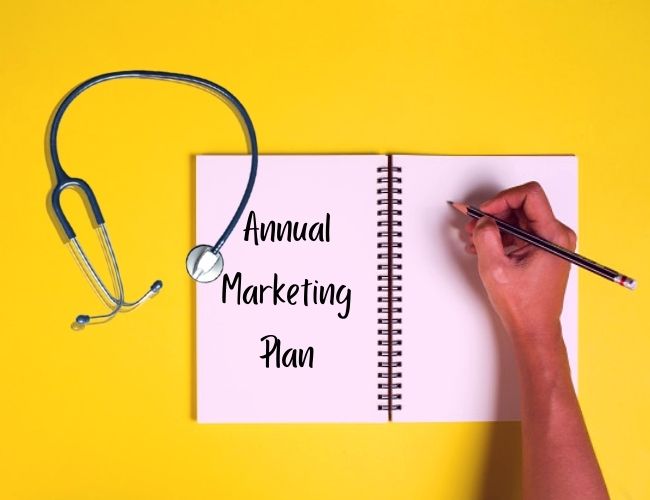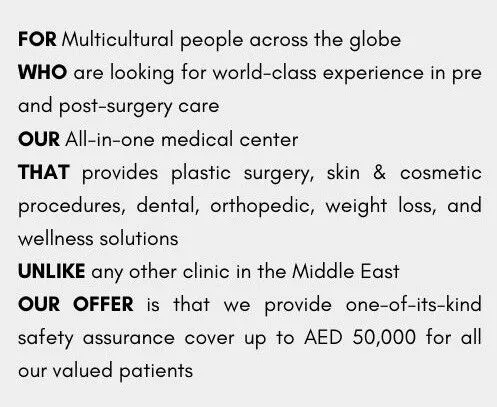Resources / Annual Practice Marketing Plan: Your Path to Net Profitability
Marketing Strategy
Learn medical marketing strategies, write a value proposition for your practice, and set your practice on the path to net profitability.


Grab a copy of this free eBook! How Much Should You Spend On Marketing: Guide for a Medical Practitioner DOWNLOAD EBOOK
Table of Contents
- Introduction
- Chapter 1: Creating Value
- Chapter 2: Writing a Value Proposition
- Chapter 3: Understanding Net Profits
- Chapter 4: The Annual Practice Marketing Plan
- 4.1 What is a Medical Practice Marketing Plan
- 4.2 Ingredients of the Practice Marketing Plan
- 4.3 A Proven Marketing Program
- 4.4 Revenue Goals and Net Profitability
- 4.5 Expense Planning and Control
- 4.6 Measuring for Success
- Frequently Asked Questions
Introduction
You might often ask yourself “Why isn’t my practice where I want it to be?” To ensure sustained growth you need to earn profits. In this eBook, we will brush over some broad financials and discuss revenue goals, expenses planning, and control. You will learn how to write a value proposition for your practice. We will also look at various marketing strategies and guidelines for creating a suitable marketing plan.
Create your Annual Marketing Plan for 2023 and set your practice on the path to net profitability.
Chapter 1: Creating Value
Think about your practice, what is your practice? Your practice is a small business. If asked, why you started your practice you may come up with various reasons. But in essence, there’s just one reason and that is to “create value”.
Look at all those patients that you have treated, most of them are happy about how they feel, how they look and they’re very grateful for your services. You are creating value for your patients. You’ve also created value for your employees and staff. You’re giving them an opportunity to make an earning, you’re creating jobs in your local community and of course, you’re teaching and training them with new techniques and procedures every day.
And most importantly, you started your practice to create value for yourself as the owner of the practice in terms of Profits. So at the end of the day, the profits are what goes into your pockets as the owner, and generating enough profit for your practice is important because it ensures that the practice remains valuable to you as well.
Chapter 2: Writing a Value Proposition
A value proposition is a formal method to clearly articulate what’s the value that your practice is creating. What that means is what are the services and products you are offering, what is the benefit of that, who’s your target customer, who’s going to benefit from that, and what makes you unique.
“A Value Proposition is a great tool to identifythe Who, What, and Why for your medical practice.”
A value proposition is a great tool to identify the who, what, and why. Who refers to your patients, understanding and segmenting your patients. What refers to what is it that you do the best, what are the services that you offer the best, basically that you have expertise in and why is your marketing objective.
The value proposition will help you define these three questions for your practice. Whereas the marketing framework will help you define the when, where, and how of your marketing strategy.
It’s not very simple to write your value proposition. Geoffrey Moore recommends using this template in his book Crossing The Chasm:

Template-of-a-Value-Proposition

The template consists of six lines. Let’s discuss each one of them:
For is your target persona. Who is your client?
Who refers to the state of mind your target persona would be in.
Our is your product or service
That is the primary benefit that you provide. What do you do? What does your clinic do?
Unlike is comparing yourself to your competitor. And when you say competitor here, you need to pick a competitor(s) who is your equal or a little better, to ensure a fair comparison.
And the last statement is Our Offer that is your point of differentiation.
You need to look at your practice, look at your objectives, your market, your services, your unique differentiator to put together your value proposition. Take a look at the value proposition of a successful clinic in Dubai (above).
Chapter 3: Understanding Net Profits
Net profitsvalue
Product or service: The product or service itself and the benefit it provides to your clients.
Customers: Who are they? How do they interact with you? Do they interact with you in your clinic (offline) or do they also interact with you online? Whether they booked an appointment with you or buy something from your online retail store that’s something you’ve got to understand.
Financial Components:
Net-Profits-for-Medical-Practices
This is how an oversimplified financial statement will look like for your practice. Net Profits: This is your net income after you have paid taxes, etc. It is derived when you subtract the operating expenses from the gross profits.
Revenues: Revenues refer to all the money that is coming in.
Costs: Cost of goods sold (COGS) is the cost of products you use to provide the services such as the Injectable COGS or the Retail COGS of the products you sell.
Gross Profits: It is that part of the revenue before any tax gets deducted and is derived when you subtract the costs (COGS) from the revenue.
Operating Expenses: These are the core expenses to operate your practice such as payroll or salary paid to your staff, money spent on marketing, and the rent of your clinic.
You’ve got to make sure that your expenses are low so that you can end up with higher profits at the end of the day.
Chapter 4: The Annual Practice Marketing Plan
So far we’ve established that your practice is a small business that is creating value, you also understand that net profits are important to create this value for your enterprise and now you know how to write a value proposition for your practice.
The question is why isn’t your practice where you want it to be.
Practice owners are letting a high potential of net profits slip through their hands every day. It’s something that can be easily overlooked. But again, if you want to be successful you have to watch your net profits because that is the value that you’re creating for yourself.
An Annual Marketing Plan will help you to detail out a strategy to promote your medical practice and in turn help you acquire more patients and/or keep them coming back.
4.1 What is a Medical Practice Marketing Plan
An annual practice marketing plan is nothing but a month-by-month plan of your marketing activities. Simply list down all the broad categories of the services you provide and focus on one broad service each month. It could be face, body, skin, hair, feminine health – focus on one service per month.
Also, factor in the seasonality when deciding on which service you want to promote in a particular month. For example, the wedding season is a good time to promote cosmetic treatments related to the face, body, or a smile makeover (wedding dentistry).
You also need to watch your revenue goals. The best thing to do here is to look at your past sales, make a list of the kind of procedures you did the most, and in effect earned the most money through. From that shortlist the top three services by revenue and cross-promote them with the services that give you the highest profit margins.
Pricing Tips for Medical Practices
Here are some tips for how you can price your marketing offers:
- You can do package pricing, cross-promotions, seasonal events
- Do a profit analysis per service and use that data when you are putting together a marketing offer
- Try to sell services with higher profits
- Utilize vendors – a lot of times vendors are willing to give some of their product as a promotion. You can use these complimentary products for your marketing promotions which will take care of the cost.
There are some popular offers such as Buy 2 Get ½ on the 3rd, Buy 5 get 6th free, etc. But try to focus on cross-promotions. Let’s say if you’re doing Botox (and Botox is your top service) then you can try to promote your RF session, so your offer can be – Buy 25 units of Botox, Get 1 RF session free.
Or let’s say you’re a dentist. You can offer a pay-as-you-go monthly dental savings plan. Or discounts on Vision and Prescription Drugs included in your Dental Plans.
When you’re putting these offers together remember the patient’s point of view. The patient should get enough value out of it. 20-25% should be the minimum offer to incentivize your clients.
For example, the standard pricing for Botox is $15 per unit. You can run an offer for $12, which is 20% off so that it gives value to your client. Similarly, you could have offers on PRP. Generally, 3 sessions are recommended, and the cost per session is $1200 – you can make a package of 3 for $3000 (20% off).
That is how they’re going to see that value and come to you, effecting a successful marketing campaign.
4.2 Ingredients of the Practice Marketing Plan
Use the following strategies and put together your annual practice marketing plan:
Offers: A sales offer on a single treatment or procedure at a discounted price or rate. For example, Flat 20% OFF on all dental procedures.
Package Offers: A special deal in which multiple services or multiple sessions of the same service are covered at a reduced price or rate. For example Save 20% on 6 sessions, or Get 5 sessions and Get 6th FREE.
Cross Promotions: Cross-selling offers to promote one procedure with the purchase of another related or complementary procedures. For example, Get 20 units of Botox FREE with 5 sessions package of RF Skin Tightening.
Referrals: Referral is the act of officially sending someone to the clinic for any treatment or procedure. In such cases, the person who refers a new patient should be rewarded with discounts or gift cards. This helps in getting new patients as well as nurturing a solid relationship with the existing patients.
Gift Cards: Gift Cards are pre-loaded cards that can be given to patients as a token of gratitude for using your services. Gift Cards can be of different brands, different monetary values, and can be issued for a particular period/service.
Sales Events: Events that are held on the premises of the clinic essentially to increase the footfall.
Seminar: A sales event to educate the audience in detail about a particular procedure and if possible demonstrate it on one or two seminar participants. This event attracts people to the clinic. A video of the event can be recorded or streamed live and more people can join in as “Webinar” participants as well. The event should have a minimum registration fee to ensure that the quality of the audience remains high.
Contest: A contest designed to gain engagement and participation from the target audience to promote services or procedures offered by the clinic.
Even memberships are a great promotional scheme. You can use memberships for recurring kinds of procedures like hydro-facials or IPL or laser hair removal or teeth cleaning and whitening and give some discounts with that membership.
Membership is a great idea because it makes your clients come back thereby increasing the lifetime value of the patients. When you have a bigger lifetime value you’re going to get a better return on the investment that you’ve made in marketing.
When looking at marketing in terms of net profitability, you need to consider these three important marketing strategies:
patient-acquisition
Acquisition: Every medical practice wants more patients. However, acquiring new patients is not easy . You need to use inbound marketing. Basically, you need to be where your patients are. Every screen. Everywhere. Every time.
A loyal customer is 5X as likely to repurchase something from you that they’ve purchased before, they are 5X more likely to forgive, 4X more likely to refer, 7X more likely to try a new offering.
Patient-Retention-Strategies
Retention: Research shows that it is 5X more expensive to acquire a new patient than to retain one. It means that you have a huge asset for your practice in terms of the patients that you have treated in the past. But how do you bring those patients back to your clinic? Mine your current client database and tune your marketing plan to bring those people back to your clinic.
practice-growth-1
Growth: Patients are increasingly showing more consumer-like behavior. 1 out of 3 patients will never return after just one bad experience. To keep growing, you need to modernize your practice to provide patients with the best customer service and customer experience they deserve. Change the way patients book appointments with you using
online appointment scheduling , conduct virtual video consultations, use online patient intake forms. Healthcare practices need to embrace cutting-edge digital technologies across all their processes for assured long-term sustained growth in this ever-evolving digital world.
4.3 A Proven Marketing Program
Cross-promotions is a great marketing tactic to expand your client base. Plan your cross-promotions in advance so you can get your vendors to support you with complimentary products.
Planning your cross-promotions ahead of time also gives you the direction on what content you or your marketing managers need to create for the month in terms of social media contests, blogs, ads, etc. This will help you synchronize all your marketing efforts towards a single goal – which is net profitability.
Look at your annual marketing plan as weekly, monthly, and quarterly buckets.

Your weekly plan can involve social media marketing and email marketing campaigns. For social media marketing, you can publish 2-3 posts in a week – create engaging posts, talk about your services, your offers, share patient reviews, etc.
Plan an email marketing campaign per week to be sent to your existing customers. What do you send them about? As a cosmetic surgeon, try to focus on a broad service every month – it might be face, body, skin, hair and focus on that for that month. Create those promotions around it and that’s what you blast to your current patients weekly. As a dentist, send weekly newsletters to educate your clients with different treatments, their benefits etc.
On a monthly basis, you can run offers in the form of Facebook and Instagram Contests. Start a contest at the beginning of the month, post stories about it frequently, and announce the winners at the end of the month.
In terms of sales, try to limit these sales to once every quarter. Because again, if you are the kind of a clinic that is discounting every week and week after week then you’re just reducing the value of your own practice. And you don’t want to dilute that value. Cross-promote so that you get more services done, you get the same patient buying something and then doing something more with you. And that usually works well.
4.4 Revenue Goals and Net Profitability
Here are some other things that you should be measuring or looking at. When you’re making your plan, decide your revenue goals by each service.
So for a plastic surgeon if it’s injectables, lasers, body contouring, skin, etc. write down your revenue goal for each procedure and for each month. Also, look at the profit margins for each of these services.
Revenue-by-service
Average-price-and-profit-margins-for-medical-practices
Revenue-goals-for-healthcare-practices
Tips-for-net-profitability
You need to create the right mix of services (as you can see in the chart) for your practice. Let’s say if you’re a plastic surgeon maybe you’re doing body contouring procedures, surgical procedures, and maybe that’s what you’re doing a lot – mix that with laser and injectables and some skin treatments and maybe include retail if you’re doing it. Create that correct or a healthy mix of services by taking into consideration the profit you will earn from it.
4.5 Expense Planning and Control
We have tackled the revenue side of the equation. The next part is to keep your expenses under control.

Benchmark yourself for the various expenditures you incur. For example, how much are you spending on payroll every month, how much you are spending on marketing, how much you are spending on the rent.
Plan the inflow and outflow of money in such a way that at the end of the day, as a successful clinic, you end up with at least 20 to 30 percent net profits. This is the value that you’re creating for yourself, the reason why you’re doing this.
4.6 Measuring for Success

Other thingsyour plan
- how many leads you’re generating every month
- how many leads are getting converted into consultations
- how many cases are booked every month (and when you’re doing those cases also try to measure them by different services)
These are the ratios that you need to keep watch on when you are looking at your plan:
Conversion Ratio:
This is the number of conversions divided by the total number of leads. When the leads are coming in, are they getting converted into a consultation? If you’re doing your marketing right, you should get a conversion ratio of up to 20% (a general standard).
Closing ratio:
After the consultation, how many of them are actually taking that procedure. The closing ratio should be pretty high, 50% is the minimum. You should target around 70%, 80% – that is, close to at least 80% of the patients that you have a consultation with.
Retention ratio:
This is a measure of the patients’ loyalty towards your practice – how many times is the patient coming back to you. Treatments like Hydra-facial, IPL, RF, Laser hair removal memberships, Skin firming, Laser facial, Brow and Lip waxing or orthodontic treatments can keep clients coming in once a month. You can even give membership cards for these and maybe a 20% discount on the package if paid upfront.
Frequently Asked Questions
Is it okay to negotiate the price of surgery with patients?
Reducing your charges is the last thing that you should do because that is devaluing or diluting your value. But there are certain options you can give them. For example, let’s say someone wants to do a rhinoplasty, maybe you should try to suggest some non-surgical ways of doing rhinoplasty like fillers for example. Try to suggest something less invasive or non-invasive, or minimally invasive.
Another example is hair transplants. You could treat patients more medically, either by vitamin therapy, nutritional therapy, or PRP, and focus on that more. Therefore, instead of dropping your price, change the service, give them an alternative, and ask them to see if that works for them.
Which social media platform is most rewarding for online marketing – Facebook, YouTube, or Instagram. What are your suggestions?
All social media platformsdifferent things
How do you attract more patients to your medical practice?
Patients these days do a lot of research as they’re going to spend a lot of money on the surgery. To attract more patients, prioritize publishing posts on social media, getting engagement with your patients, educating them on different procedures through your website, and cross-promoting certain services to existing patients.
How much should a medical practice spend on marketing?
There isn’t a standard formula, however, by the rule of thumb, your marketing spend should be about 10% to 15% of your projected annual revenues or total annual sales. This also depends on factors such as the stage in your practice, the specialties or services you provide, the markets that you operate in, and the number of providers in your practice.

About Author
Harshal Limaye
CEOFounder
LinkedIn – @ Harshal Limaye
Harshal Limaye runs Mktg.Doctor, an all-in-one digital marketing platform that leverages 360° marketing strategies to acquire new patients, re-engage existing patients, improve patient’s experience, streamline your front desk, and justify your marketing spend. He is a Certified Aesthetic Consultant from The Aesthetic Academy USA.
Cookie settings
We use cookies to provide you with the best possible experience. They also allow us to analyze user behavior in order to constantly improve the website for you.
Necessary Analytics Preferences Marketing





















